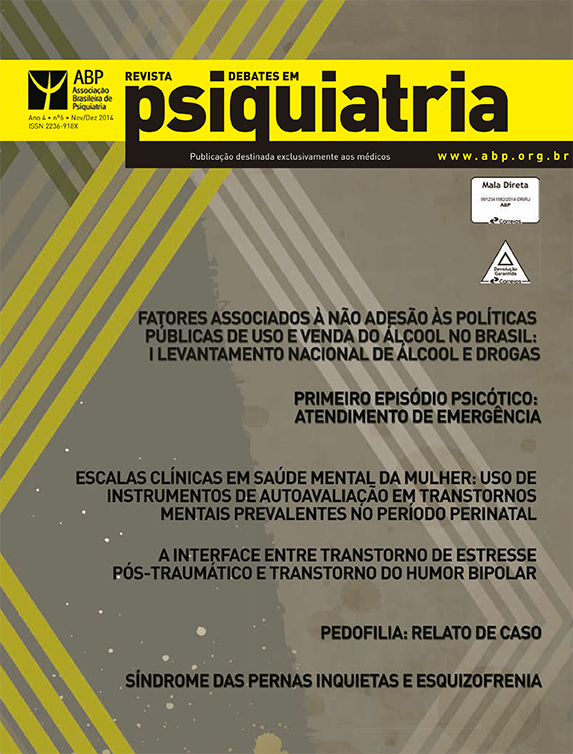The boundaries between post-traumatic stress disorder and bipolar disorders
DOI:
https://doi.org/10.25118/2236-918X-4-6-4Keywords:
Post-traumatic stress disorder, dysphoria, bipolar mood, treatmentAbstract
The 5th edition of the Diagnostic and Statistical Manual of Mental Disorders (DSM-V) has emphasized the presence of persistent mood symptoms in post-traumatic stress disorder (PTSD). This paper describes the case of a patient with PTSD who presented persistent mood changes and required revision of the traditional pharmacological approaches adopted. The challenge in treating these cases is how to address the combination of symptoms, so as to treat both PTSD and dysphoria simultaneously. The use of mood stabilizers is in line with current pathophysiological theories, but more studies are necessary to prove the real effectiveness of these drugs in the treatment of the “dysphoric PTSD subtype”.
Downloads
Metrics
References
Associação Americana de Psiquiatria. Manual Diagnóstico e Estatístico de Transtornos Mentais, 4ª edição (DSM-IV). Porto Alegre: Artes Médicas; 1995.
Kessler RC, Sonnega A, Bromet E, Hughes M, Nelson CB. Posttraumatic stress disorder in the National Comorbidity Survey. Arch Gen Psychiatry.1995;52:1048-60.
Breslau N, Kessler RC, Chilcoat HD, Schultz LR, Davis GC, Andreski P. Trauma and posttraumatic stress disorder in the community: the 1996 Detroit Area Survey of Trauma. Arch Gen Psychiatry. 1998;55:626-32.
Quarantini LC, Netto LR, Andrade-Nascimento M, Almeida AG, Sampaio AS, Miranda-Scippa A, et al. [Comorbid mood and anxiety disorders in victims of violence with posttraumatic stress disorder]. Rev Bras Psiquiatr. 2009;31:S66-76.
Nardi AE, Kapczinski F, Quevedo J, Hallak JE, Freire R, Romano-Silva MA. The quest for better diagnosis: DSM-5 or RDoC? Rev Bras Psiquiatr. 2013;35:109-10.
Foa E. Guideline 6: Psychopharmacotherapy for adults. In: Effective treatments for PTSD. 2nd ed. New York: Guilferd; 2009.
Hansen M, Armour C, Elklit A. Assessing a dysphoric arousal model of acute stress disorder symptoms in a Programa de Atendimento e Pesquisa em Violência (PROVE), Departamento de Psiquiatria, Escola ARTIGO Paulista de Medicina – Universidade Federal de São Paulo (EPM-UNIFESP), São Paulo, SP. clinical sample of rape and bank robbery victims. Eur J Psychotraumatol. 2012;3.
Phillips ML, Vieta E. Identifying functional neuroimaging biomarkers of bipolar disorder: toward DSM-V. Schizophr Bull. 2007;33:893-904.
Rakofsky JJ, Ressler KJ, Dunlop BW. BDNF function as a potential mediator of bipolar disorder and posttraumatic stress disorder comorbidity. Mol Psychiatry. 2012;17:22-35.
Iwata M, Ota KT, Duman RS. The infl ammasome: pathways linking psychological stress, depression, and systemic illnesses. Brain Behav Immun. 2013;31:105-14.
Soeiro-de-Souza MG, Dias VV, Figueira ML, Forlenza OV, Gattaz WF, Zarate CA Jr, et al. Translating neurotrophic and cellular plasticity: from pathophysiology to improved therapeutics for bipolar disorder. Acta Pychiatr Scand. 2012;126:332-41.
Naviaux RK. Metabolic features of the cell danger response. Mitochondrion. 2014;16:7-17.
Downloads
Published
How to Cite
Conference Proceedings Volume
Section
License

This work is licensed under a Creative Commons Attribution-NonCommercial 4.0 International License.
Debates em Psiquiatria allows the author (s) to keep their copyrights unrestricted. Allows the author (s) to retain their publication rights without restriction. Authors should ensure that the article is an original work without fabrication, fraud or plagiarism; does not infringe any copyright or right of ownership of any third party. Authors should also ensure that each one complies with the authorship requirements as recommended by the ICMJE and understand that if the article or part of it is flawed or fraudulent, each author shares responsibility.
Attribution-NonCommercial 4.0 International (CC BY-NC 4.0) - Debates em Psiquiatria is governed by the licencse CC-By-NC
You are free to:
- Share — copy and redistribute the material in any medium or format
- Adapt — remix, transform, and build upon the material
The licensor cannot revoke these freedoms as long as you follow the license terms. Under the following terms:
- Attribution — You must give appropriate credit, provide a link to the license, and indicate if changes were made. You may do so in any reasonable manner, but not in any way that suggests the licensor endorses you or your use.
- NonCommercial — You may not use the material for commercial purposes.
No additional restrictions — You may not apply legal terms or technological measures that legally restrict others from doing anything the license permits.






























